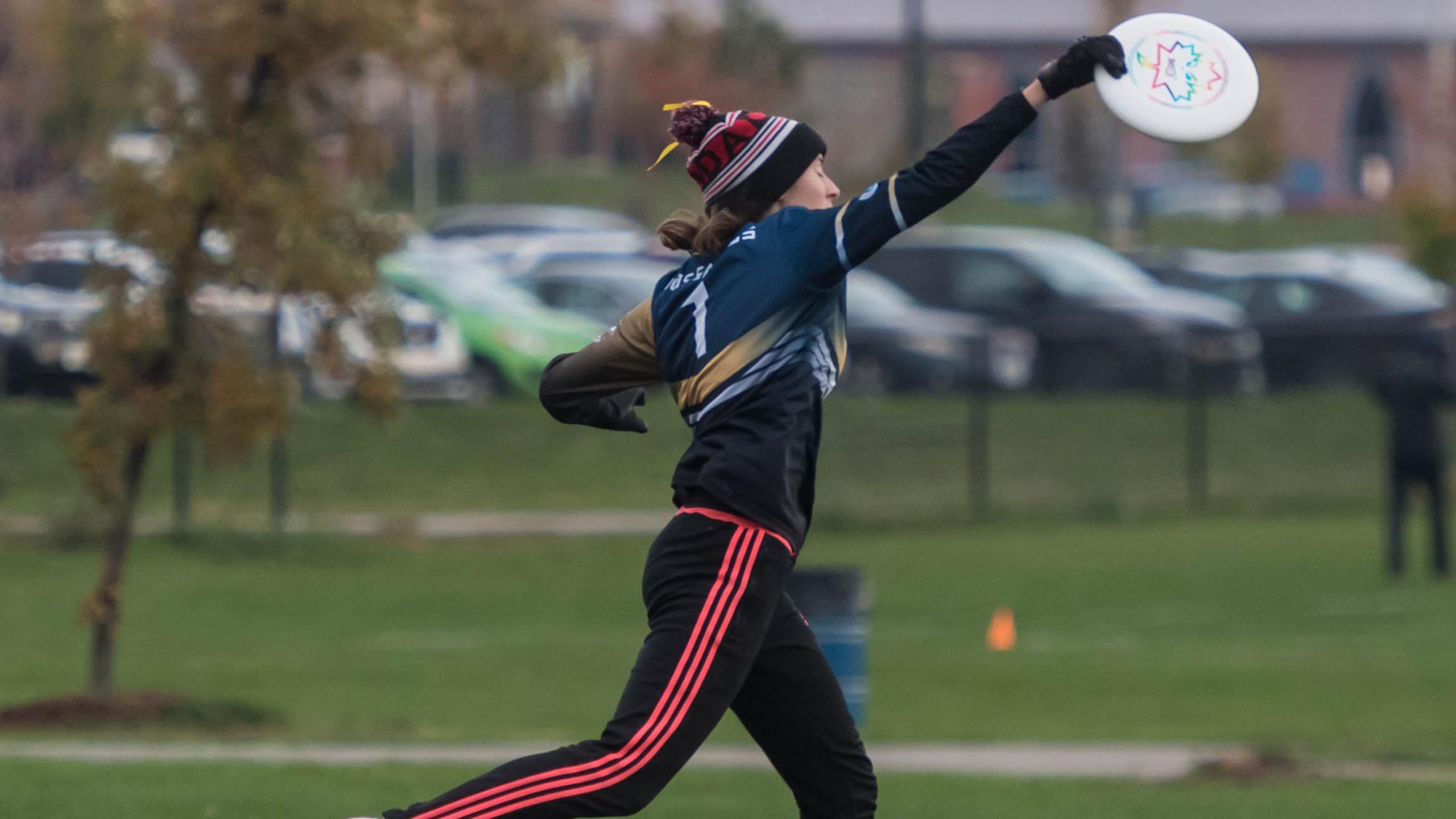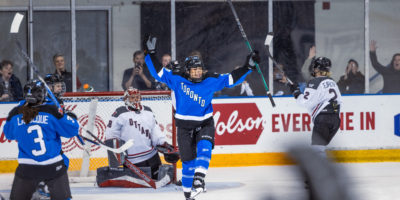By Kayla Zhu
I picked up my first 175-gram Discraft disc in the summer of 2008 during an ultimate frisbee summer camp.
As an eight-year-old girl playing against 13 and 14-year-old boys, I mostly ran around the field in circles, hoping someone would pass to me. They never did.
It wasn’t until the last day of the camp, after three days of squirreling around the field and eagerly awaiting a pass, that I finally touched the disc.
I remember the moment vividly: an opposing player threw a flick to a boy I was dutifully marking. I sprinted to catch up to him as he cut under and I smacked the frisbee to the ground, intercepting the pass. My teammates were astounded. Instinctively, I picked up the disc and threw a wobbly backhand to the end zone where a girl on my team caught it.
A defensive block, then a point. In ultimate, we call that a “double happiness.” Pretty fitting.
Victoria Ta, the team captain and third-year Ryerson professional communications student, has been playing university ultimate ever since her first year. In that time, Ryerson and York University combined their girls team to create the “Yorkerson” team, due to a lack of female participants in both schools.
However, in the 2017-2018 school year, Ryerson was able to create their own women’s team. This school year saw an influx of new players trying out.
“I was really surprised. We actually had to cut girls for the first time,” said Ta. “A lot of our team this year were first years, more than we would usually have. I think it’s due to their overall interest in the sport.”
Ultimate frisbee is also one of the only sports where co-ed teams compete at the highest levels of play.
In Canada, high school teams are co-ed. Mixed ultimate is played frequently in recreational leagues and at the national level with competitive club teams. Every two years, the Team Canada U24 mixed team represents Canada in World Flying Disc Federation (WFDF) 2018 World Ultimate Club Championships (WUCC).
Co-ed play comes with a host of considerations. Women not getting passed to, injuries and a shortage of female players are some of the most common issues in recreational play. And it is in these recreational leagues where female ultimate players start dipping their feet into the sport.
Toronto Ultimate Club (TUC), the main recreational ultimate organization in Toronto, aims to combat these issues through female-focused programming and policymaking.
“All our initiatives are informed by the feedback provided to us from our female members,” said Patrick Russell, the board representative for TUC’s Women’s Committee.
It’s in these recreational leagues where female ultimate players start dipping their feet into the sport
Such initiatives include the creation of the player Harassment Policy to help establish sanctions for harassment of female ultimate players, female-only skill development sessions, and most prominently, an even gender-player ratio.
“The goal of this initiative is to increase the quality and quantity of engagement of female players in TUC games,” said Russell.
“As a governing body, the biggest thing we can do is help change policy,” said Rebecca Thompson, the communications manager at Ultimate Canada.
“We can’t change policies for leagues, but we can encourage leagues to say ‘Hey look, we’re doing the equal gender ratio at the highest levels, there’s no reason you can’t do it in a league.’”
At the national level, Ultimate Canada has the power to make and change policies that effect Canada’s most competitive teams.
Beyond switching to the equal gender ratio in their mixed nationals, the organization also ensures that there is equal livestream coverage of female and male games during national championships, and that the first finals time slot rotates every year.
“Because we’ve been a growing minority sport for a long time, we have a chance to put our minority players within our minority sport in the spotlight,” said Thomson. “We are a smaller sport that has the chance to look at how other professional sports did it before us and do it differently.”
Equal coverage and an equal gender ratio are major strides in promoting female ultimate but Adriana Withers of VC Ultimate Inc., a prominent North American ultimate apparel company, believes that equitable action is needed to level the playing field for female players.
Withers designed VC Ultimate’s “The Future is Female” merchandise line in 2017 with the goal of being a “conversation sparker” when her staff wore it at tournaments.
“I think one of the first things you have to start talking about when you talk about equality is equitable action to achieve equality,” said Withers. “The statement ‘The Future is Female’ is embodying equitable action.”
In a blog post, Withers asserts that “as a community, we need to focus energy and resources on the development of female athletes and their competitive opportunities to make up for so much lost ground.”
“The idea is that the future needs to be female because the past was male. We’re not starting at the same level.”
As the CEO of VC Ultimate and a board member of the WFDF Women in Sport Commission, Withers has noticed the lack of females in leadership positions in the ultimate community.
“The phrase I really like is ‘You can’t be what you can’t see’,” said Withers. “I think more women in leadership will encourage more women to try to put their hat in a leadership position. It also puts a different perspective.”
Krystal Dos Santos, a Chang School student in the publishing program, believes that having skilled, confident players on a team gives more developing players something to mimic and work towards.
She recounts that in the past, Ryerson has had a hard time finding interested women who had any ultimate experience.
“This year, having coaches and having great handlers and cutters to show people decision making has been really great,” said Dos Santos, who joined Ryerson’s roster this school year after playing for the University of Toronto in her undergrad. “That’s something you can’t learn without seeing it—knowing when someone is open or staying on the open side on defense, things like that.”
Dos Santos is among the top echelon of elite women’s players in Toronto. She has played several seasons with the Toronto 6ixers, Toronto’s top competitive women’s ultimate team. Her competitive team’s season overlaps with the university series, and many of her teammates opt out of playing for their schools due to risk of injury.
“They said, ‘Why are you going to play? You’re in the Division 2, it’s not going to be great ultimate’,” said Dos Santos, who took on a major leadership role within the team this year. “It might not be great ultimate but our team is super fun and everyone learns so quickly. We’re a great group of girls.”
“We’ve improved so much. The team has made me so proud.”
Dos Santos has played competitively and recreationally for years now, experiencing the transition to the 3-3 ratio in TUC leagues and other female development initiatives firsthand.
“Our team is super fun and everyone learns so quickly. We’re a great group of girls”
But, in her opinion, coverage is one of the most powerful and effective ways organizations can push female ultimate.
“When more women see women playing ultimate, they think ‘Hey, I can do that too’,” said Dos Santos. “Younger players who are just coming up, they can see women doing amazing things and instead of just knowing that woman from rec league who no one throws to, they start seeing women who are real athletes out there and know that it is possible to get to that stage.”
In 2017, Jesse Shofner became the first female to play on a major league ultimate team, joining the Nashville Nightwatch.
In early 2019, the Premier Ultimate League, a new professional women and non-binary ultimate league, was created. The league’s goals are to increase accessibility and visibility of womxn players through high-quality competition, leadership experiences, and community partnerships. The league includes cisgender and transgender womxn, non-binary, and intersex people.
In 2016, the All-Star Ultimate Tour, a group of hand-picked, elite college-aged female ultimate players travelled across the United States, playing the best women’s ultimate team at each of their stops.
The team took a little trip up to my hometown, Vancouver. There, I got to watch some of the best female players in the world match up against women I had been idolizing my entire life from Vancouver Traffic, the top women’s team in Vancouver.
It was 90 minutes of the most elite women’s ultimate I had ever witnessed in person. I watched with 20 of my summer club teammates by my side, all of us wide-eyed and gripping the edge of the bleachers. It was at that moment I realized just how powerful women’s ultimate coverage was.
Perhaps if eight year-old Kayla had watched that game before her summer camp, she would have picked up the disc much earlier.











Leave a Reply